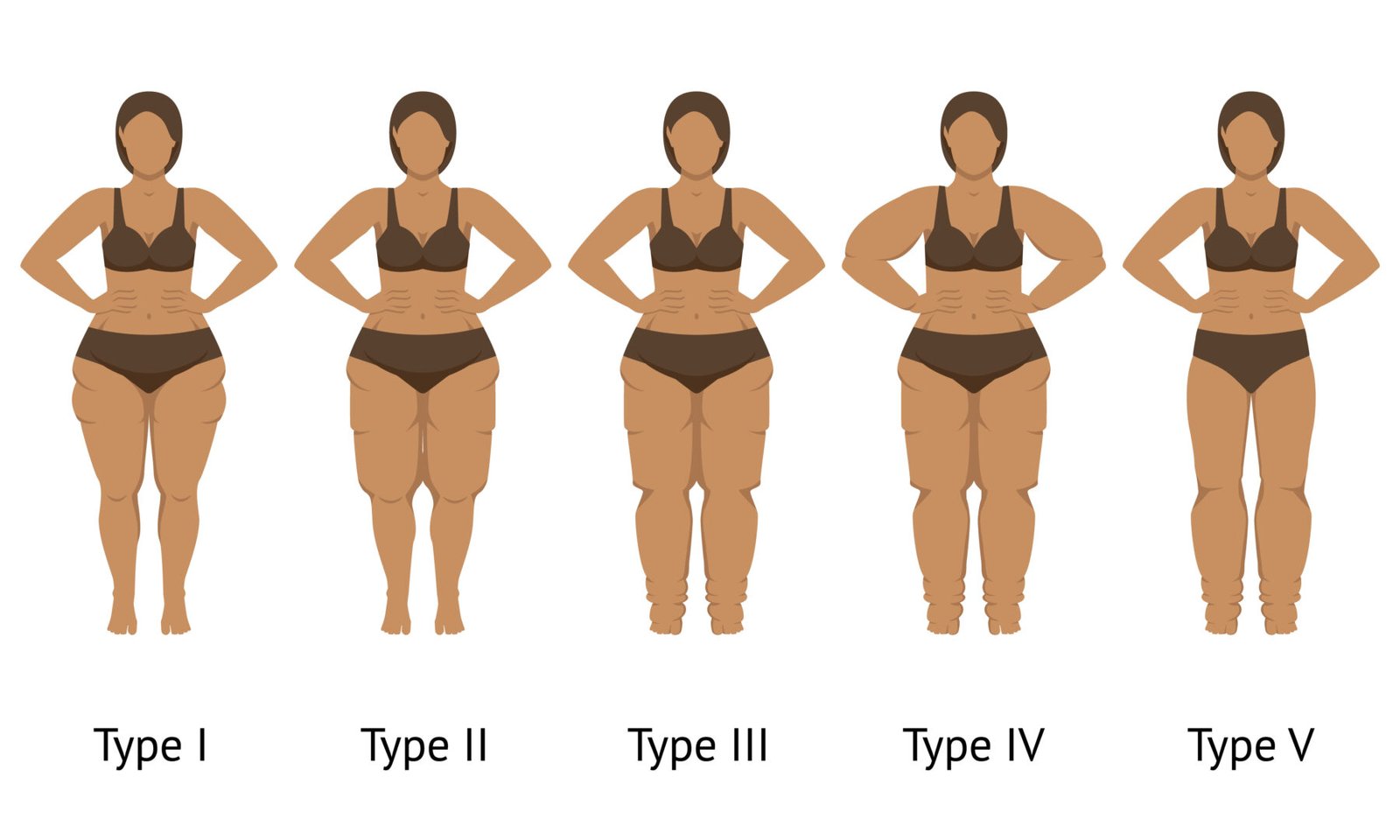The Role of Diet for Lipedema
Finding an effective diet for lipedema can be a game-changer for those affected by this chronic condition. Lipedema primarily impacts women and causes abnormal fat accumulation in the lower body, leading to pain, swelling, and reduced mobility. Many women receive misdiagnoses of general obesity or lymphedema, which hinders proper treatment.
The ketogenic diet, known for its low carbohydrate and high-fat approach, is a promising dietary intervention for managing lipedema. This diet helps reduce body weight and fat while significantly alleviating pain and improving mobility.
In this article, we’ll explore recent scientific studies supporting the ketogenic diet’s role in managing lipedema. By understanding the ketogenic diet and its benefits, individuals with lipedema can explore a potentially effective way to manage symptoms and enhance their quality of life.
Lipedema: Prevalence and Impact
Lipedema, a chronic condition marked by the abnormal accumulation of fat, primarily affects women. In the United States, approximately 11% of women suffer from lipedema, translating to millions dealing with its challenging symptoms.
Despite its prevalence, many women receive misdiagnoses, often being told they have general obesity or lymphedema. This misdiagnosis leads to ineffective treatment strategies. In Canada, the situation mirrors that of the U.S., with similar prevalence rates expected due to comparable risk factors and health profiles.
In the United States, approximately 11% of women suffer from lipedema, translating to millions dealing with its challenging symptoms.
Symptoms and Challenges
Lipedema causes pain, swelling, and disproportionate fat accumulation in the legs, buttocks, and sometimes arms. These symptoms lead to reduced mobility and significant discomfort.
Traditional weight loss methods, such as calorie restriction and exercise, often prove ineffective in addressing the specific fat deposits associated with lipedema. This makes finding alternative treatments crucial for those affected.

Lipedema not only affects physical health but also impacts mental well-being. The pain and discomfort can hinder daily activities, leading to a lower quality of life. Additionally, the condition often causes emotional distress due to its chronic nature and the societal misunderstanding surrounding it. Clearly, effective management strategies are essential for improving the lives of those with lipedema.
Lipedema not only affects physical health but also impacts mental well-being.
The pain and discomfort can hinder daily activities, and it often causes emotional distress due to its chronic nature and the societal misunderstanding.
Basic Principles of the Ketogenic Diet
The ketogenic diet focuses on drastically reducing carbohydrate intake while increasing the consumption of healthy fats. This dietary shift forces the body into a state of ketosis, where it burns fat for energy instead of glucose. Typically, the diet includes about 70-75% of calories from fat, 20-25% from protein, and only 5-10% from carbohydrates.
In ketosis, the liver converts fats into ketones, which become the primary energy source. This metabolic change helps reduce fat deposits, making it particularly beneficial for conditions like lipedema, characterized by abnormal fat accumulation.

Keto Diet Benefits Beyond Lipedema
The ketogenic diet offers numerous health benefits beyond managing lipedema. These include:
- Weight Loss: By promoting fat burning, the diet helps with significant weight loss.
- Improved Insulin Sensitivity: Lower carbohydrate intake helps regulate blood sugar levels and improve insulin sensitivity.
- Reduced Inflammation: The diet’s anti-inflammatory effects can alleviate symptoms of various chronic conditions.
- Enhanced Mental Clarity: Many individuals report improved focus and mental clarity while on a ketogenic diet.
Scientific Support for the Ketogenic Diet in Lipedema Treatment
Short-term Effects on Body Composition and Pain
A recent study published in the journal Diabetes, Metabolic Syndrome & Obesity sheds light on how a ketogenic diet can significantly improve the lives of those suffering from lipedema.
The study found that patients who adhered to a low-carbohydrate, high-fat ketogenic diet experienced substantial reductions in body weight, body fat, and pain levels.
Participants on the ketogenic diet reported improvements in their quality of life, including better physical function and reduced discomfort.
One standout finding was that “the ketogenic diet led to a significant decrease in body fat percentage and overall weight,” which are critical factors in managing lipedema symptoms. Additionally, pain reduction was one of the most noticeable benefits, enhancing daily functioning and mental well-being.
“…the ketogenic diet led to a significant decrease in body fat percentage and overall weight,” which are critical factors in managing lipedema symptoms.
Additionally, pain reduction was one of the most noticeable benefits, enhancing daily functioning and mental well-being.
Long-term Benefits of the Diet for Lipedema
A comprehensive study, published in the journal MDPI provides valuable insights into the long-term benefits of the ketogenic diet for individuals suffering from lipedema.
This study meticulously tracked a patient’s progress over nearly two years, demonstrating the diet’s effectiveness in managing and alleviating lipedema symptoms.
The study documented significant improvements in the patient’s condition, noting that “the ketogenic diet led to a marked reduction in body weight and fat.”
Traditional weight loss methods often prove ineffective for lipedema patients, but the ketogenic diet directly addresses this issue by reducing fat deposits and overall body weight. The study highlighted that pain reduction was one of the most consistent and significant outcomes observed, underscoring the diet’s role in improving quality of life.

Another key aspect of the study is the sustained nature of the benefits. Over the 22-month period, the patient maintained improvements in weight, fat reduction, and pain management. This long-term follow-up provides compelling evidence that a ketogenic diet is not just a short-term fix but a viable long-term strategy for managing lipedema.
Over the 22-month period, the patient maintained improvements in weight, fat reduction, and pain management.
This long-term follow-up provides compelling evidence that a ketogenic diet is not just a short-term fix but a viable long-term strategy for managing lipedema.
Potential Mechanisms and Benefits
A recent study, published in the journal Medical Hypotheses, explores how a ketogenic diet might help manage lipedema symptoms. The researchers highlighted several potential benefits, including significant reductions in body weight and fat, which are critical in managing lipedema.
The study found that “pain reduction was one of the most consistent and significant outcomes observed,” improving physical functioning and overall quality of life for patients. Additionally, the ketogenic diet can improve metabolic and hormonal functions, reduce inflammation, and potentially prevent fibrosis.
The authors believe that the diet’s effectiveness may be due to its ability to induce ketosis, shifting the body’s energy source from glucose to fats. This metabolic change can lead to reduced insulin levels and improved insulin sensitivity, which are crucial for patients with lipedema.
The study found that “pain reduction was one of the most consistent and significant outcomes observed,” improving physical functioning and overall quality of life for patients.
Practical Tips for Adopting a Ketogenic Diet for Lipedema
Adopting a ketogenic diet for lipedema can seem challenging, but breaking it down into manageable steps can help. Start by gradually reducing your carbohydrate intake. Begin with cutting out high-carb foods such as bread, pasta, and sugary snacks. Replace them with low-carb vegetables, lean meats, and healthy fats.
Focus on whole, unprocessed foods to ensure you get the nutrients your body needs. Incorporate plenty of leafy greens, avocados, nuts, flax seeds, and high-quality proteins like beef,ish, chicken, and eggs. It’s also essential to stay hydrated, as the ketogenic diet can have a diuretic effect.
Meal Planning and Recipes
Effective meal planning can simplify the transition to a ketogenic diet. Here are some tips:
- Breakfast Options: Consider meals like scrambled eggs with spinach and avocado or a chia seed pudding made with coconut milk.
- Lunch Ideas: Opt for salads with mixed greens, grilled chicken, olive oil, and a sprinkle of nuts.
- Dinner Suggestions: Enjoy dishes like baked salmon with asparagus or a hearty beef stir-fry with bell peppers and broccoli.
- Snacks: Keep it simple with nuts, cheese, or a handful of olives.

Planning your meals ahead of time can prevent impulsive, high-carb eating and help you stay on track.
On the go? Preparation is key! Read: Road Trip Food Planner for Keto Dieters
Monitoring Progress
Tracking your progress is crucial when adopting a ketogenic diet for lipedema. Keep a food diary to record your daily intake and note any changes in your symptoms. Monitoring your weight, body measurements, and pain levels can provide valuable insights into how the diet affects you.

Key Takeaways
- Effective Weight and Fat Reduction: Scientific studies have shown that a ketogenic diet can significantly reduce body weight and fat, directly addressing one of the core issues of lipedema.
- Significant Pain Relief: One of the most consistent findings across studies is the reduction in pain, which improves daily functioning and mental well-being for those with lipedema.
- Improved Mobility: By reducing pain and swelling, the ketogenic diet enhances mobility, allowing individuals to engage more fully in their daily activities.
- Long-term Benefits: Research indicates that the benefits of a ketogenic diet for lipedema are not just short-term. Patients have maintained improvements in weight, fat reduction, and pain management over extended periods.
- Overall Health Improvements: Beyond managing lipedema symptoms, the ketogenic diet offers additional health benefits, including better insulin sensitivity, reduced inflammation, and improved mental clarity.
- Practical Implementation: Adopting a ketogenic diet involves gradually reducing carbohydrate intake, focusing on whole, unprocessed foods, and planning meals to maintain consistency.
Final Thoughts
In conclusion, adopting a ketogenic diet offers a promising approach for managing lipedema. Scientific studies have demonstrated its effectiveness in reducing body weight, fat, and pain, while also improving mobility and overall quality of life. These benefits are not only significant but also sustainable over the long term, providing hope for those struggling with this chronic condition.
The ketogenic diet stands out as an important alternative to traditional weight loss methods, which often fail to address the specific needs of lipedema patients. By focusing on a low carbohydrate and high-fat intake, individuals can experience substantial health improvements.
For those considering this dietary change, it’s essential to start gradually, focus on whole foods, and monitor progress. Consulting with healthcare professionals can help tailor the diet to individual needs, ensuring a balanced and effective approach.
If you or a loved one suffers from lipedema, exploring the ketogenic diet could be a transformative step towards better health and well-being. With its potential to alleviate symptoms and improve daily functioning, the ketogenic diet offers a natural and effective way to manage lipedema.
References:
- Potential therapeutic effect of a ketogenic diet for the treatment of lymphoedema… Journal of Human Nutrition & Dietetics
- Ketogenic diet as a potential intervention for lipedema. Medical Hypotheses
- Management of Lipedema with Ketogenic Diet: 22-Month Follow-Up. MDPI
Keto PowerFlax Baking Mix: Keto & So Much More!

- Commercial Bakeries: you can easily produce delicious flax-based keto-friendly products which are clean label, high protein, high fiber and plant-based!
- Works with your current equipment and baking processes.
- Recipes provided on all bulk orders, with ongoing customer support
- Worldwide shipping
- Get in touch with us today!

What to Read Next:
- How Many Carbs a Day on Keto? – Your Ultimate Guide
- Natural Appetite Control: How Keto Curbs Your Hunger
- Is Keto an Anti-Aging Diet? What the Science Says
- Mental Health, Mitochondria & Keto: Feel Better Naturally
- Rethinking Obesity: Why Overeating Is Not the Culprit
- Keto Diet For Migraines: Prevention and Relief (New Study)

